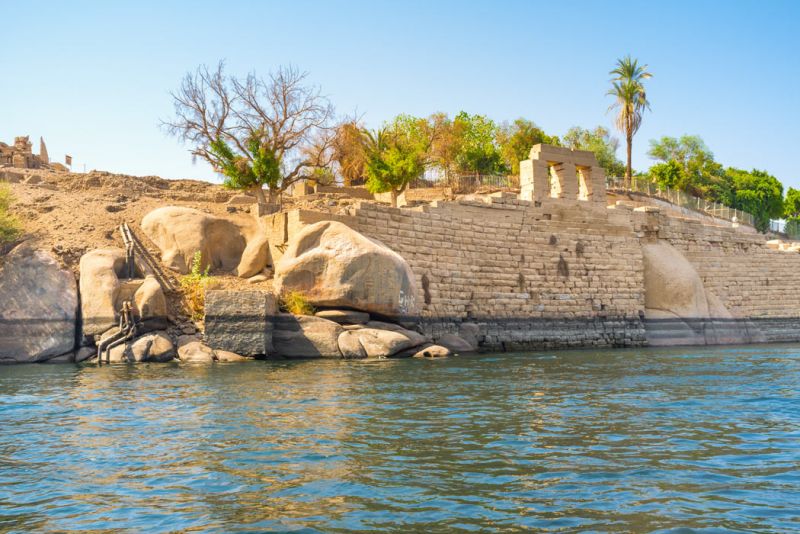Elephantine Island
- Where is Elephantine Island Located?
- How to get to Elephantine Island?
- Elephantine Island at Ancient Times
- The Temples of Elephantine Island
- The Nilometer
- The Aswan Museum
- Jewish presence on the Island
Gaining its name by its shape which resembles standing elephants in the water, or others would say an elephant tusk; Elephantine Island offers a variety of attractions for anyone visiting the beautiful city of Aswan.
Where is Elephantine Island Located?
Measuring a total of 1200 meters from north to south and 400 meters at its widest point, Elephantine Island and other neighboring Islands can be spotted from the west bank hillside along the Nile River and is located just downstream from the first cataract in the Nile, in the border between Upper Egypt and Lower Nubia.
How to get to Elephantine Island?
It is possible to reach Elephantine Island by ferry or on a felucca that can be rented from the banks of the river in Aswan.
Elephantine Island at Ancient Times
In ancient times, before the city of Aswan was there, Elephantine Island was the site of a Pharaonic era trading town called Swenet, which used the island and the turbulent waters of the First Cataract as protection from attack. Its strategic location just below the cataract made it an important trade hub, where caravans from the south unloaded their goods to be transported north on the river. Elephantine Island was also once an important trading center for the ivory trade, providing granite for the construction of many buildings in ancient Egypt.
Left behind from this Pharaonic settlement is the late-Pharaonic era Temple of Khnum and other, partially excavated, ruins that are scattered over the rest of the island. The island also hosts the Aswan Museum and an ancient nilometer in the form of ancient stairs leading into the water cut into the rock that displayed markings in Arabic, Roman and Pharaonic numerals. In the middle of the island, palm groves hide two Nubian villages that regularly host tourists and beautiful scenery along the river. There is also a luxurious hotel, the Movenpick Aswan, located at its northern end.

The Temples of Elephantine Island
The Temple of Thutmose III and Amenhotep III were once stood in the sites of the Elephantine Island, but these were destroyed once Muhammad Ali took control over Egypt and enforced the Muslim religion over its lands.
The first temple built on the island was the Temple of Satet around 3000 BC; the temple went under renovations and modifications over the next 3000 years. Records show the existence of an Egyptian temple of Khunum on the Third Dynasty, which temple was completely rebuilt during the Thirtieth Dynasty of Egypt just before the Greco-Roman period.

The Nilometer
Another famous attraction for tourists visiting the Elephantine Island is the Nilometer. It was originally built to measure the Nile’s water levels and clarity during the annual flood season.
Two nilometers are located on the elephantine island; the most popular one is a corridor nilometer which is associated with the Temple of Satis being one of the oldest nilometers in Egypt.

The Aswan Museum
Located on the south-eastern side of Aswan on Elephantine Island, the Aswan Museum is a popular site among tourists visiting this region. Opened to the public since 1912, the Aswan Museum contains many artifacts that tell the story about the region of Nubia. Another section of the museum was opened in 1990 which displays objects discovered on the grounds of Elephantine Island itself, objects such as potteries, mummies, weapons, and utensils. Many of these objects and artifacts have been discovered by the German Archaeological Institute, including a mummified ram of Khnum, and a rare calendar, famously known as the Elephantine Calendar of Things from the reign of Thutmose III.

Jewish presence
A Jewish community is documented to have once lived within the Elephantine Island around the 5th century BC; they built and maintained their own temple where sacrifices were offered to many gods as they followed the polytheistic beliefs.
Visit the beautiful Elephantine Island and much more with one of our Egypt Classic Tours.
